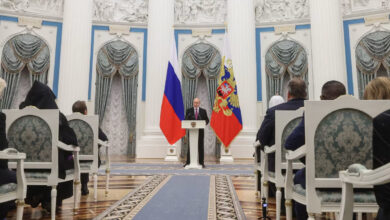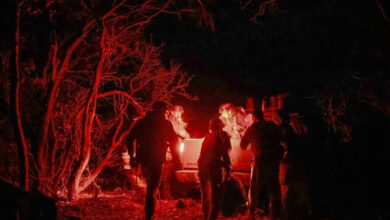
Americans on Saturday came to grips with recommendations to wear masks against the coronavirus, while Spain added to hopes that Europe could be turning a corner in the pandemic with a second daily drop in deaths.
China meanwhile came to a standstill as the nation where the virus first appeared held three minutes of silence to mourn the patients and medical staff killed by the outbreak.
Since COVID-19 emerged late last year, more than 1.1 million people have fallen ill. Nearly 60,000 people have died.
Across China, cars, trains and ships sounded their horns, and air-raid sirens wailed, as flags were flown at half-staff from 10 am (0200 GMT).
“I feel a lot of sorrow about our colleagues and patients who died,” said Xu, a nurse who worked on the front lines in the central city of Wuhan, where the virus was initially detected.
“I hope they can rest well in heaven.”
China, where over 3,000 people have died from the virus, appears to be over the worst of its outbreak and there are signs of normality returning.
But large swathes of the world remain in crisis mode.
Europe accounts for the lion’s share of virus fatalities, but America logged another rise in its death toll to bring the total to just over 7,100.
President Donald Trump’s administration on Friday suggested widespread use of simple masks or scarves might help slow the spread — even if the US leader said he himself wouldn’t be following the advice.
“It’s going to be really a voluntary thing,” Trump said. “You don’t have to do it and I’m choosing not to do it, but some people may want to do it and that’s okay.”
Anthony Fauci, head of infectious diseases at the National Institutes of Health, cited “recent information that the virus can actually be spread even when people just speak as opposed to coughing and sneezing.”
The World Health Organization has been more cautious, saying the airborne threat was only known to occur during certain medical treatments.
The US recommendation will likely worsen an already severe shortage of masks in the United States and Europe, which both rely heavily on imports from China.
Officials in New York, the worst affected part of the US, began advising people to wear masks some days ago, and there were signs on the streets that the advice was being heeded.
“I am trying to protect me and my family. If everybody protects themselves, it’s better for all of us,” Eddie Marrero, a 58-year-old handyman, told AFP.
– Hope in Europe –
In Europe, Italy and Spain continue to bear the brunt of a pandemic that has kept millions of citizens confined to their homes, closed schools and businesses and overwhelmed healthcare systems.
But official figures suggested unprecedented measures to restrict people’s movements were working and that the peak may have hit on the continent.
Spain, which is under a near-total lockdown, on Saturday recorded a second successive daily fall in coronavirus-related deaths with 809 fatalities.
The total number of deaths in the country now stands at 11,744, second only to Italy.
The number of new Spanish cases also slowed at 7,026, taking the total to 124,736.
Spaniard Javier Lara survived after being put on oxygen in an overcrowded intensive care unit — a shock to a 29-year-old who was athletic and does not smoke.
“I was panicking that my daughter would get infected. When I started showing symptoms, I said I wouldn’t hold her or go near her,” he said, describing facing death with an eight-week-old as the “worst moment” in his life.
Italy reported late Friday that the daily rise of officially registered infections dropped to a new low of just four percent, while the number of people who had fully recovered was rising.
“The numbers are improving,” said Giuli Gallera, chief medical officer of Italy’s worst-hit Lombardy region.
“Our hospitals are starting to breathe.”
– Easter holidays –
European governments have nevertheless warned citizens not to expect a loosening of the restrictions anytime soon.
In Germany, where the death toll rose again on Saturday, Chancellor Angela Merkel said figures showing the virus’s spread was slowing “give us a little bit of hope”.
“But it is definitely much too early to see a clear trend in that, and it is certainly too early to think in any way about relaxing the strict rules we have given ourselves,” she said.
German authorities joined the US and other countries in encouraging citizens to wear self-made masks in public, prompting a flurry of online tutorials and debate about how to maximize protection.
In France, 160,000 police officers and gendarmes fanned out nationwide to ensure people were heeding the confinement rules despite the start of the Easter holidays, when French families traditionally head to the beach, countryside or mountains.
Interior Minister Christophe Castaner said security forces would be carrying out checks “day and night” at stations, on motorways and at tourist destinations.
– ‘Worst yet to come’ –
There was yet another warning over the fate of the less developed world, especially conflict zones or places with large refugee populations.
“The worst is yet to come,” UN Secretary-General Antonio Guterres said, referring to countries such as Syria, Libya and Yemen. “The COVID-19 storm is now coming to all these theatres of conflict.”
The world economy has been pummelled by the virus and associated lockdowns, with millions more people signing on for unemployment payments in the US.
Financial ratings agency Fitch predicted the US and eurozone economies would shrink this quarter by up to 30 percent.
Latin America is heading into a “deep recession” with an expected drop of 1.8 to 4.0 percent in GDP, according to the UN.
burs-mfp/lc
Image: AFP / Angela Weiss Officials in New York, the worst affected part of the US, began advising people to wear masks some days ago, and there were signs on the streets that the advice was being heeded




